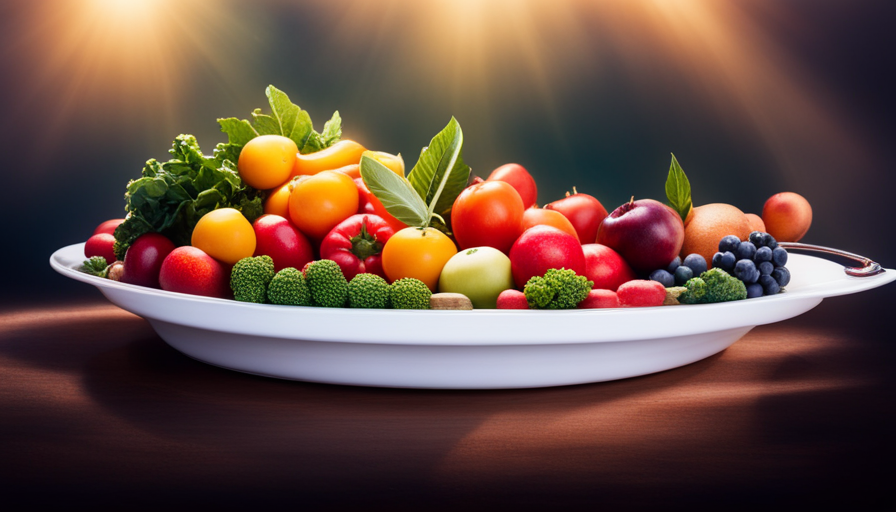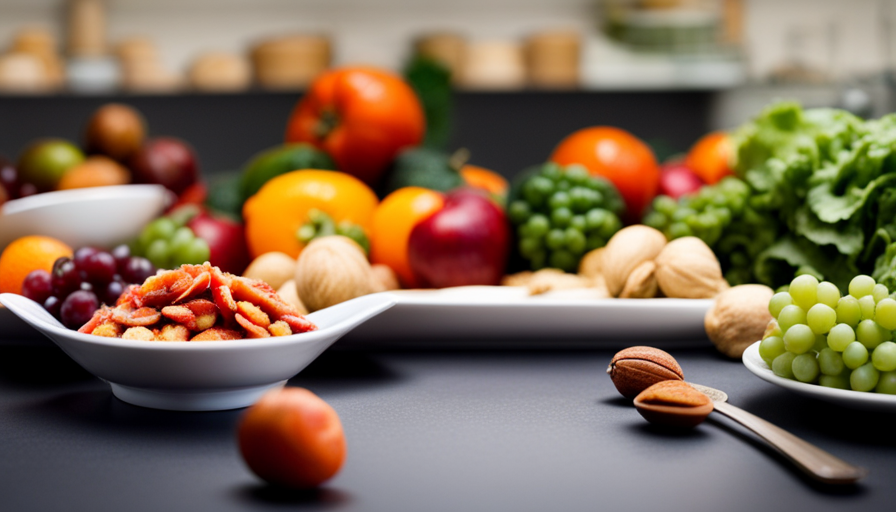Did you know that fermentation is the crucial process responsible for creating numerous popular food and beverage items like yogurt, cheese, and beer? It is a fascinating natural occurrence that changes the flavor, texture, and health benefits of different foods.
But have you ever wondered if cooking affects the speed of fermentation? Well, I have some interesting news for you. According to recent studies, raw food actually ferments faster than cooked food. This means that if you’re looking to harness the benefits of fermentation in your cooking, opting for raw ingredients might be the way to go.
In this article, we will explore the science behind fermentation, the factors that affect its speed, and the differences between cooked and raw food in the fermentation process. So, let’s dive in and uncover the secrets of this ancient culinary technique.
Key Takeaways
- Fermentation occurs faster in raw food compared to cooked food.
- Factors like temperature, pH levels, salt concentration, and the presence of oxygen influence raw food fermentation.
- Cooking can slow down fermentation by affecting microorganism activity and denaturing enzymes.
- The presence of enzymes and microorganisms in raw food ensures a faster and more efficient fermentation process.
What is Fermentation?
So, you’re probably wondering what fermentation is all about, right? Well, let me break it down for you.
Fermentation is a natural process that converts carbohydrates, like sugars and starches, into alcohol or organic acids, using yeast or bacteria. This process has been used for centuries to produce various food and beverages, such as bread, beer, yogurt, and pickles.
Now, let’s talk about the benefits of fermentation. One of the main advantages is that it can enhance the nutritional value of food. During fermentation, beneficial bacteria or yeast break down complex molecules, making them easier to digest and increasing the availability of certain nutrients. Additionally, fermentation can help preserve food, extending its shelf life and reducing the risk of spoilage.
The process of fermentation is quite fascinating. It starts with the introduction of microorganisms, such as yeast or bacteria, to the food substance. These microorganisms consume the carbohydrates present in the food, producing byproducts like alcohol, carbon dioxide, or organic acids. This metabolic activity creates the unique flavors, textures, and aromas associated with fermented foods.
Now that you understand the basics of fermentation, let’s delve into the details of how it works and why it plays a vital role in the speed of fermentation.
The Process of Fermentation
When it comes to the process of fermentation, there are two key points to consider: how fermentation works and the microorganisms involved in the process.
Fermentation is a metabolic process that converts sugar into acids, gases, or alcohol, and it occurs in the absence of oxygen. During fermentation, microorganisms such as yeast or bacteria play a crucial role in breaking down the sugars and producing the desired end product.
How Fermentation Works
To really understand how fermentation works, you’ve got to imagine tiny little microorganisms partying it up in your food, creating a flavor explosion like no other!
Fermentation benefits us in many ways, particularly when it comes to our gut health. During the fermentation process, these microorganisms break down sugars and convert them into alcohol, lactic acid, or other byproducts. This not only gives fermented foods their unique tangy taste, but it also creates a perfect environment for good bacteria to thrive in our digestive system.
These beneficial bacteria help digest food, produce vitamins, and support our immune system. So, next time you enjoy a delicious batch of sauerkraut or yogurt, remember that it’s not just your taste buds having a party, but also the microorganisms in your gut! They play a crucial role in fermentation and our overall well-being.
Now, let’s dive into the fascinating world of the microorganisms involved in fermentation.
Microorganisms Involved in Fermentation
Get ready to be amazed by the incredible world of microorganisms that are the life of the party in fermentation! These tiny creatures play a crucial role in the process of turning raw food into delicious fermented beverages.
Yeasts are the star players when it comes to fermentation. They convert sugars into alcohol and carbon dioxide, giving us the delightful bubbles in our favorite beverages.
Another group of microorganisms, known as lactic acid bacteria, also contribute to fermentation by converting sugars into lactic acid.
The activity of these microorganisms is greatly influenced by temperature. Warmer temperatures tend to speed up fermentation, while cooler temperatures slow it down.
So, the next time you enjoy a refreshing glass of fermented beverage, remember the microorganisms that made it possible.
Now, let’s dive into the fascinating factors that affect fermentation.
Factors Affecting Fermentation
When it comes to fermentation, three key factors play a significant role: temperature, pH level, and oxygen availability.
Temperature affects the rate at which fermentation occurs, with higher temperatures typically resulting in faster fermentation.
The pH level of the environment also influences fermentation, as certain microorganisms thrive in acidic or alkaline conditions.
Lastly, oxygen availability can impact fermentation by either promoting or inhibiting the growth of specific microorganisms.
Temperature
If you cook your food at a higher temperature, it’ll ferment faster, resulting in a more rapid breakdown of nutrients and flavors. Did you know that increasing the cooking temperature by just 10 degrees Celsius can speed up the fermentation process by about 20%? Heat has a significant influence on fermentation because it affects the activity of enzymes. Enzymes are responsible for breaking down complex molecules into simpler forms during fermentation. When the temperature increases, enzymes become more active, leading to a faster breakdown of nutrients and flavors in the food. This is because heat causes enzyme denaturation, which alters their structure and enhances their activity. Therefore, cooking food at higher temperatures can accelerate the fermentation process.
Moving on to the next topic, pH level also plays a crucial role in fermentation.
pH Level
The acidity of the environment profoundly impacts the fermentation process, leaving our taste buds tingling with delight. The pH level plays a crucial role in determining the speed and efficiency of fermentation. When the pH is too high or too low, it can hinder the growth of fermenting organisms and slow down the process. A pH level of around 4-5 is generally optimal for most fermentations.
To better understand the impact of pH on fermentation, let’s take a look at the table below:
| pH Level | Fermentation Rate |
|---|---|
| 2-3 | Slow |
| 4-5 | Optimal |
| 6-7 | Slower |
| 8-9 | Very slow |
| 10-11 | Almost no activity |
In addition to pH, the presence of sugar is also crucial for fermentation. Sugar acts as a food source for the fermenting organisms, allowing them to produce the desired flavors and textures.
As we transition to the next section on oxygen availability, it’s important to note that pH and sugar are just some of the factors influencing the fermentation process.
Oxygen Availability
Oxygen availability greatly affects the fermentation process, and interestingly, a lack of oxygen can actually enhance the flavors and textures of the final product.
When oxygen is present, aerobic fermentation occurs, which is slower compared to anaerobic fermentation that takes place in the absence of oxygen. Oxygen availability plays a crucial role in determining the speed of fermentation.
In anaerobic conditions, microorganisms convert sugars into acids, alcohols, and gases, which contribute to the characteristic flavors and textures of fermented foods. This process is faster than aerobic fermentation because microorganisms can quickly break down sugars without the need for oxygen.
Understanding the impact of oxygen availability on fermentation speed is crucial when considering the differences between cooked and raw food. Oxygen availability, along with other factors, can influence the rate at which fermentation occurs in these food types.
Differences Between Cooked and Raw Food
When it comes to discussing the differences between cooked and raw food, there are several key points to consider.
Firstly, cooking has a significant impact on the nutritional content of food. Heat can cause the loss of certain vitamins and minerals, while also increasing the availability of others.
Secondly, cooking can dramatically change the texture of food. Raw food is often crisp and firm, while cooking can soften or even break down the structure of the food.
Lastly, cooking can greatly enhance the flavor of food. The Maillard reaction, which occurs when food is heated, creates complex flavors and aromas that aren’t present in raw food.
Impact of Cooking on Nutritional Content
Cooking significantly alters the nutritional content of food, making it a hot topic for nutrition enthusiasts. When food is cooked, it undergoes various changes that can affect its nutrient composition.
The effect of cooking on nutrient loss depends on the cooking method and the specific food being cooked. However, in general, cooking can cause a loss of certain heat-sensitive nutrients, such as vitamin C and B vitamins.
On the other hand, cooking can also enhance the availability of certain nutrients and make them more easily absorbed by the body. For example, cooking can increase the bioavailability of lycopene in tomatoes. Additionally, cooking can break down anti-nutrients, such as phytic acid, making nutrients more accessible.
Overall, the impact of cooking on the nutritional content of food should be considered when making dietary choices.
Moving on to changes in texture and flavor…
Changes in Texture and Flavor
After exploring the impact of cooking on the nutritional content of food, it’s important to delve into the changes in texture and flavor that occur as a result.
Cooking alters the physical properties of food, leading to transformations in both its texture and taste. For instance, vegetables become softer and more tender when cooked, while meat can become juicier and easier to chew. These changes in texture can greatly influence our perception and enjoyment of a dish.
Additionally, cooking can enhance the flavor of food by releasing and intensifying certain compounds. However, it’s worth noting that the heat applied during cooking can also cause the loss of certain volatile compounds, potentially diminishing the overall flavor profile.
With a clear understanding of the impact on nutritional content, it’s now crucial to explore how cooking affects the fermentation process.
Does Cooking Affect the Fermentation Process?
If you’re looking to speed up the fermentation process, cooking your food can be a game-changer! The impact of heat on the fermentation process is significant, and it can greatly influence the speed at which food ferments.
When food is cooked, the heat breaks down the cell walls and denatures enzymes, which are responsible for the fermentation process. This breakdown allows for a quicker release of sugars and nutrients, making them more accessible to the microorganisms that drive fermentation. As a result, cooked food tends to ferment at a faster rate compared to raw food.
Studies have shown that the comparison of fermentation speed in cooked and raw food is quite noticeable. For example, when fermenting vegetables like cabbage to make sauerkraut, cooked cabbage ferments faster than raw cabbage. The heat applied during cooking softens the cabbage, making it easier for the fermentation process to begin. Additionally, the breakdown of cell walls through cooking leads to a quicker release of sugars, providing more food for the fermentation bacteria.
Cooking can have a significant impact on the speed of fermentation. The heat applied during cooking breaks down cell walls and denatures enzymes, allowing for a faster fermentation process. However, the question still remains: does raw food ferment faster? Let’s explore that in the next section.
Does Raw Food Ferment Faster?
In my experience, raw food tends to ferment faster due to its higher content of natural enzymes and microorganisms. These enzymes and microorganisms play a crucial role in the fermentation process by breaking down the food’s carbohydrates and proteins into simpler compounds.
Additionally, factors such as temperature, humidity, and the presence of oxygen can also influence the speed of raw food fermentation.
Raw Food’s Natural Enzymes and Microorganisms
Raw food bursts with a vibrant array of natural enzymes and microorganisms, infusing it with a lively energy that accelerates the fermentation process. These natural enzymes and microorganisms are essential for the breakdown of complex carbohydrates and proteins, making raw food an ideal candidate for fermentation.
When it comes to raw food benefits, the presence of these enzymes and microorganisms ensures that the fermentation process isn’t only faster but also more efficient. The enzymes break down the food into simpler forms, while the microorganisms convert sugars into alcohol, acids, and gases, creating unique flavors and textures.
Raw food fermentation techniques take advantage of these natural enzymes and microorganisms to enhance the flavor and nutritional value of the food. From sauerkraut to kimchi, these traditional fermentation methods have been used for centuries to preserve and transform raw ingredients.
Transitioning into the next section about factors that influence raw food fermentation, it’s important to understand how temperature, pH levels, and the presence of salt can impact the fermentation process.
Factors that Influence Raw Food Fermentation
Transition: Now that we understand the natural enzymes and microorganisms present in raw food, let’s explore the factors that influence raw food fermentation.
Current Subtopic: Factors That Influence Raw Food Fermentation
When it comes to fermenting raw food, several factors play a significant role in the process. These factors include temperature, pH levels, salt concentration, and the presence of oxygen. The right combination of these elements creates an optimal environment for the growth and activity of beneficial bacteria and yeasts, which facilitate fermentation.
To help visualize these factors, let’s consider a 2-column, 5-row table:
| Factors | Influence |
|---|---|
| Temperature | Affects the speed of fermentation. |
| pH levels | Determines the type of microorganisms present. |
| Salt concentration | Controls the growth of harmful bacteria. |
| Oxygen | Can promote or hinder fermentation. |
| Time | Duration for fermentation to occur. |
Understanding these factors allows us to harness the benefits of fermented raw foods, such as increased nutrient bioavailability, improved digestion, and enhanced immune function.
Transition: Now that we have explored the factors that influence raw food fermentation, let’s delve into the question of whether cooking slows down fermentation.
Does Cooking Slow Down Fermentation?
In my research, I’ve found that cooking can indeed slow down fermentation. One reason for this is that heat has a direct effect on microorganism activity, which is necessary for fermentation to occur.
Additionally, cooking can denature enzymes, which are essential for the fermentation process. These factors combined can have a significant impact on the speed at which food ferments.
Heat’s Effect on Microorganism Activity
Cooking food is like turning up the heat on microorganism activity. The effect of temperature on microbial growth is significant and can either inhibit or promote fermentation. Here are four key points to consider:
-
Optimal temperature: Different microorganisms have different temperature preferences for growth and fermentation. Some thrive in lower temperatures, while others prefer higher temperatures.
-
Heat kills: High temperatures can kill or slow down the growth of microorganisms, reducing their ability to ferment food. This is why cooking can slow down fermentation.
-
Accelerated fermentation: On the other hand, cooking can also create an environment that promotes fermentation by breaking down the food’s cellular structure and releasing nutrients that microorganisms feed on.
-
Control and safety: Cooking allows for better control over fermentation processes, ensuring that harmful bacteria are killed and food is safe to consume.
As we explore the subsequent section about the denaturation of enzymes, we’ll delve deeper into how heat affects the fermentation process.
Denaturation of Enzymes
Get ready to witness the incredible impact of heat on enzymes as they undergo denaturation, taking your culinary journey to new heights of flavor and texture.
Denaturation refers to the process in which enzymes lose their structure and function due to exposure to heat. When enzymes are subjected to high temperatures, the weak bonds that maintain their shape break, causing them to unfold and lose their ability to catalyze chemical reactions.
This denaturation of enzymes can have significant effects on the activity of microorganisms involved in fermentation. By altering the structure of enzymes, heat can either enhance or inhibit their activity, ultimately affecting the speed at which food ferments.
Now, let’s explore some examples of fermented cooked foods and discover the fascinating world of culinary transformation.
Examples of Fermented Cooked Foods
Some delicious examples of fermented cooked foods include sauerkraut, kimchi, and pickles. These foods undergo a fermentation process that occurs after they’ve been cooked. The impact of cooking on fermentation flavors can be quite interesting, as it can enhance the flavors and create a unique taste profile.
-
Sauerkraut: This classic fermented cabbage dish is made by shredding cabbage and fermenting it with salt. The cooking process helps soften the cabbage leaves and infuses them with a tangy and sour flavor.
-
Kimchi: A staple in Korean cuisine, kimchi is made by fermenting vegetables such as cabbage, radishes, and cucumbers. Cooking the vegetables before fermentation helps release their natural flavors and allows them to absorb the spicy and tangy seasonings.
-
Pickles: Pickles are made by fermenting cucumbers or other vegetables in a brine solution. Cooking the vegetables before fermentation helps draw out excess water and intensify their flavors, resulting in crunchy and tangy pickles.
-
Fermented hot sauce: Some hot sauces, like Tabasco, are made by fermenting peppers and other ingredients. Cooking the peppers before fermentation helps develop a complex and fiery flavor profile.
Fermenting cooked foods offers various benefits, such as increased shelf life, improved digestibility, and enhanced nutrient availability. However, it’s important to note that not all cooked foods are suitable for fermentation. Some foods may lose their fermentability when cooked at high temperatures or for extended periods. Transitioning to the subsequent section about examples of fermented raw foods, we explore another side of fermentation that highlights the unique flavors and benefits of preserving raw ingredients.
Examples of Fermented Raw Foods
Now that we’ve explored some examples of fermented cooked foods, let’s shift our focus to the world of fermented raw foods.
Raw food fermentation offers its own set of benefits and techniques that are worth exploring. Fermenting raw foods not only preserves their nutritional value but also enhances their flavors. Raw food fermentation allows beneficial bacteria to thrive, creating a rich source of probiotics that support digestive health and boost the immune system.
Popular examples of fermented raw foods include sauerkraut, kimchi, and kombucha.
To ferment raw foods, you need to create the right environment for beneficial bacteria to grow. This involves using a saltwater brine or a starter culture to kickstart the fermentation process. The raw ingredients are then left to ferment at room temperature for a certain period, allowing the bacteria to work their magic.
Raw food fermentation techniques can vary depending on the specific food being fermented. For example, sauerkraut is made by fermenting shredded cabbage with salt, while kimchi involves fermenting a mix of vegetables with spices and chili paste.
Exploring the world of fermented raw foods reveals a wide variety of options and benefits. However, to fully understand the impact of cooking on fermentation speed, we need to delve into the next section.
Conclusion: The Impact of Cooking on Fermentation Speed
If you want to experience the true lightning-fast transformation of flavors and the explosive burst of beneficial bacteria, imagine the impact that cooking has on the speed of fermentation. The process of cooking can significantly affect the rate at which raw food ferments. Here are four ways in which cooking impacts microbial activity and fermentation speed:
-
Heat: Cooking involves subjecting food to high temperatures, which can kill or inhibit the growth of certain microorganisms. This can slow down the fermentation process compared to raw food, where the microorganisms are still active.
-
Enzyme denaturation: Cooking can denature enzymes present in raw food. Enzymes play a crucial role in the fermentation process by breaking down complex molecules into simpler ones. When enzymes are denatured, their activity is reduced, which can lead to slower fermentation.
-
Moisture loss: Cooking often involves the removal of moisture from food, which can impact microbial activity. Microorganisms require a certain level of moisture to thrive and carry out fermentation. If the moisture content is reduced through cooking, it can slow down the fermentation process.
-
Cooking methods: Different cooking methods, such as boiling, steaming, or baking, can have varying effects on microbial activity and fermentation speed. For example, boiling may kill more microorganisms compared to steaming, resulting in slower fermentation.
Cooking can have a significant impact on the speed of fermentation. Factors like heat, enzyme denaturation, moisture loss, and cooking methods all contribute to the differences in fermentation speed between cooked and raw food.
Frequently Asked Questions
How does the temperature impact the fermentation process?
The temperature plays a crucial role in the fermentation process. It directly affects the fermentation rate, with higher temperatures generally leading to faster fermentation. However, each type of fermentation has an optimal temperature range for achieving the desired results.
For example, beer fermentation typically occurs between 20-25°C, while yogurt fermentation occurs at a slightly lower temperature range of 40-45°C. Maintaining the optimal temperature is essential for ensuring successful fermentation and obtaining the desired product.
What are some common signs of fermentation in food?
When it comes to food fermentation, there are several common signs of spoilage to look out for. These include a sour or tangy smell, fizzy or bubbly texture, and a change in taste or appearance.
To prevent food fermentation, it’s important to store food properly in airtight containers, keep it at the right temperature, and avoid cross-contamination. By following these steps, you can ensure that your food stays fresh and free from fermentation.
Can fermented foods be harmful to consume?
Fermented foods can have potential risks if not prepared or stored properly. The fermentation process can create an environment where harmful bacteria, such as Clostridium botulinum, can thrive. However, when fermented foods are made using safe and proper fermentation techniques, the risks are minimized.
It’s important to follow guidelines for fermentation, such as using clean equipment, monitoring temperatures, and storing fermented foods at the correct temperature.
Are there any specific health benefits associated with consuming fermented foods?
Consuming fermented foods can have specific health benefits for our gut health and immune system. These foods are rich in beneficial bacteria and enzymes that promote a healthy gut flora. This can improve digestion, nutrient absorption, and even support weight management.
Additionally, fermented foods can strengthen the immune system by enhancing the production of antibodies and reducing inflammation. Incorporating fermented foods into our diet can be a natural and effective way to support our overall health and well-being.
Is it possible to ferment foods without using salt or other additives?
Yes, it’s possible to ferment foods without using salt or other additives. There are alternative fermentation techniques that can be used, such as using whey or a starter culture. These methods rely on the natural bacteria present in the food and don’t require the addition of salt or other additives. While salt is commonly used in fermentation to control the growth of harmful bacteria, it isn’t always necessary for successful fermentation.
Does Cooking Method Affect the Fermentation Process of Food?
The cooking method can definitely affect the fermentation process of food. For example, using different heat levels or cooking times can alter the fermentation process, leading to different flavors and textures in the end product. This can be seen in the pancakes vs hotcakes comparison, as each cooking method results in a distinct taste and texture due to the fermentation process.
Conclusion
In conclusion, after exploring the impact of cooking on fermentation speed, it’s evident that cooking does affect the process.
While raw food tends to ferment faster due to its natural enzymes, cooking slows down the fermentation process. However, it’s important to note that there are examples of fermented cooked foods as well.
So, while cooking may not completely halt fermentation, it certainly slows it down considerably. Overall, the impact of cooking on fermentation can be likened to a tortoise racing against a hare, where the tortoise represents the slowed fermentation process.

















